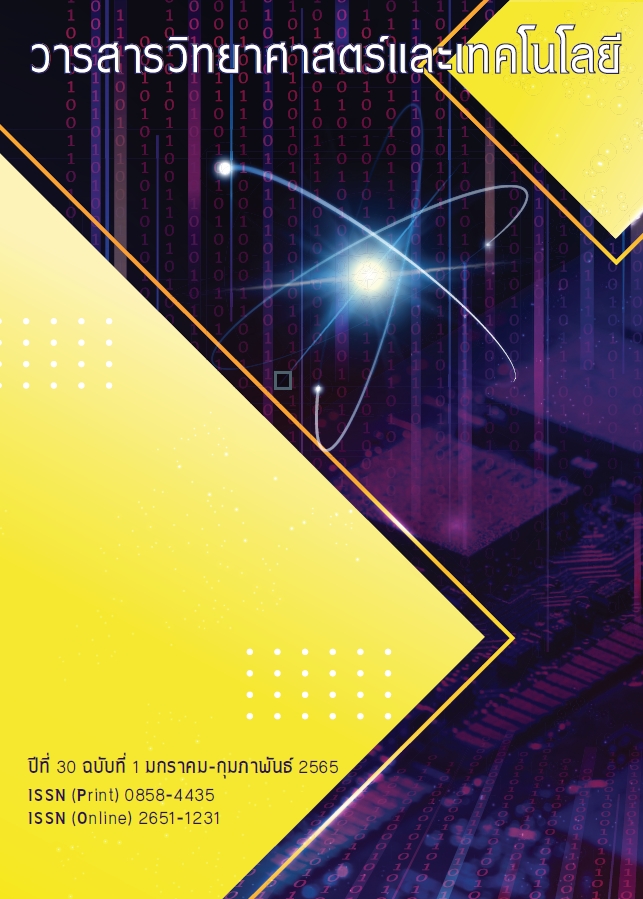Comparison of the Efficacy of Cleaning Agents for the Surface of Laboratory Benches in Microbiology Laboratory at Faculty of Medicine, Thammasat University
Main Article Content
Abstract
This research aimed to compare the efficacy of cleaning agents for the surface of laboratory benches in Microbiology Laboratory at the Faculty of Medicine, Thammasat University. The experiment was set up to investigate the efficacy of cleaning agents, including the detergent group
(i.e., 0.5% washing powder) and antiseptic group. For antiseptic group it could be divided into 2
sub-groups, which were disinfection solution (i.e., 70% alcohol and 0.5% sodium hypochlorite) and ready-to-use disinfectant (i.e., 0.5&% commercially available solution). Tap water was used as a
control. Samples were collected from the surface of the laboratory table by a swab test method which was performed on an area of 25.81 square centimeters (4 square inches), a total of 4 areas per cleaning agent. The tests were conducted before and after the cleaning with tested agents on the days that had the microbiology laboratory lessons. The experiments were performed on 7
occasions with 10 tested tables and 20 samples per occasion. The different efficiencies among cleaning products in different periods were investigated using the colony count method, and
one-way ANOVA was used to evaluate statistically different. The results before cleaning the number of microorganisms found were no different disinfectant. After cleaning, the number of microorganisms found was significantly different (p<0.05). Data on the growth of microorganisms when using different cleaning agents before and after cleaning were recorded. It was found that the mean microbial count before cleaning was in the range of 9.39 - 18.18 CFU / cm2 while the mean microbial count after cleaning was 0.39 – 2.14 CFU / cm2. The results before and after the cleaning usage with Scheffe method, there was no different disinfectant property between before and after cleaning laboratory benches when using 0.5% washing powder, 70% alcohol, 0.5% sodium hypochlorite, and 0.5% readyto-use disinfectant. Further bacterial identification of all isolates showed Staphylococcus sp. and Bacillus sp. both before and after cleaning. When analyzing the average number of
microorganisms, it was found that 0.5% ready-to-use disinfectant and 70% alcohol were the best destruction of Staphylococcus sp. and Bacillus sp., respectively.
Article Details
References
Chedsada Noppawinyoowong, Chayanid Sornchaithawatwong, Janya Srisangchun, Sarin Tadtong and Amornrat Viriyaroj, Chemical Stability of 70% Alcohol after Opened, SMJ Res. J. 2557; 29:282- 6 p.(in Thai)
Nanthawan Jinakul, Duangjai Chanton and Kanpitcha Namchan, The comparison of disinfectant efficiency among cleansing agents for Cell Culture Laboratory, BJM Res. J. Vol.4 No.2 July-December 2017. (in Thai)
Witchuda thongking, Pornsawan Sukprasert, Orasa Seesamer, Inthuorn Rinlue, Supanida Kampume and Yuparat Limmongkon, Commparison of Total Bacteria Concentration on Computer Keyboards with Different Clean Methods, KKU Res. J. Vol.11 No.2 April – June 2018. (in Thai)
Siriwan Wichai, Nusara yinyom, Khwan Aumdee, Suchao Timkreajeen, Pheera samphao-ngeen, Chanunchida Muangthong and Suwanna Numphitsanu, Decontamination of Microorganisms on Books, Journals and the Media by 10% Hydrogen Peroxide Disinfectant, PULINET Journal Vol.6, No.3, September–December 2019 : pp.68-76. (in Thai)
Phonlawat Janpiw, Comparison of Bactericidal Efficacy between Ethanol- and Clorox®-containing Disinfectants in Laboratories, SMJ Res. J. 2561; 33(5): 444-450. (in Thai)
Pennapa Sriring, Kanchana Sanukul, Awirut Singhakui and Chutima Wichitranuwat, Production of sterile drug and sterile drug, 1st ed. Praboromarajchanok Institute; 2011. (in Thai)
Thai industrial standard TIS. 78-2006, Laundry detergent powder, Thai industrial standards institute (TIST): Ministry of
Industry; 2007. (in Thai)
Arumrat Ratchadaruk. Standard of laundry detergent power and development of laundry detergent power, TIST
Magazine 2005; 31: 6-7. (in Thai)
Morton HE. Alcohols. In: Block SS, editor. Disinfection sterilization and Preservation. 3rd ed. Philadelphia: Lea & Febiger, 1983: 225-39.
Wannaporn Srisukontharat, Household or Public Health antimicrobial agents. Food and drug Administration, Ministry of Public Health; 2015. (in Thai)
M.H Wilcox, W.N Fawley, N. Wigglesworth, P. Parnell, P. Verity, J. Freeman. Comparison of the effect of detergent versus
hypochlorite cleaning on environmental contamination and incidence of Clostridium difficile infection. Journal of Hospital Infection. 2004 Jul; 57(3): 267.
Laboratorie Huckert’s International. Innovation in Cold Disinfection. [Internet]. [accessed October 04, 2017]. Available from:http://huckerts.net/en/umonium38/.
Paolo Raffo, A.C. Salliez, Christian Collignon and Massimo Clementi. Antimicrobial activity of a formulation for the low temperature disinfection of critical and semi-critical medical equipment and surfaces. New Microbiology. 2007; 30:463-69.
M. Exner, V. Vacata, B. Hornei, E. Dietlein, J. Gebel. Household cleaning and surface disinfection: new insights and strategies.
Journal of Hospital Infection. April 2004, pp. 70-75.

